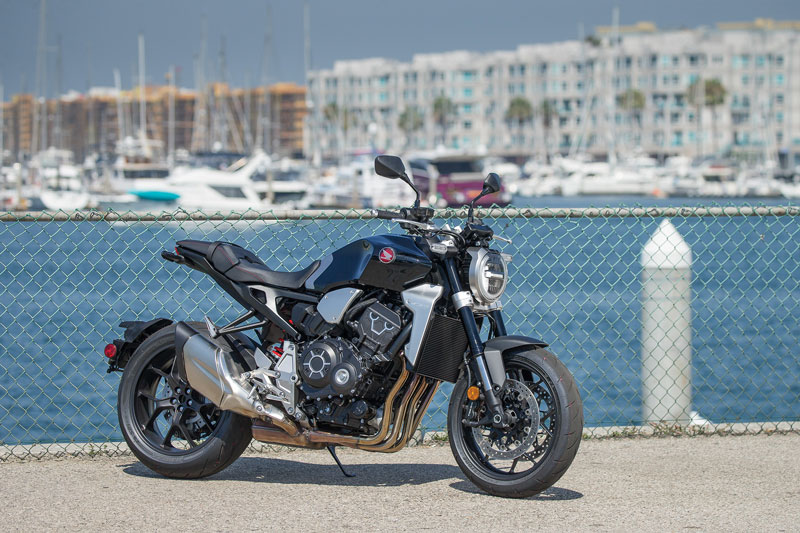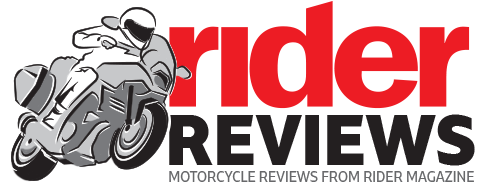2018 Honda CB1000R

Road Test Review
Since its 2011 debut, the Honda CB1000R has languished. It arrived when American buyers weren’t particularly interested in naked bikes, and its mediocre performance and ho-hum styling didn’t help. But what a difference a few years can make.
Naked bike sales have more than doubled since 2012, and the average buyer is 45-55 years old with two decades of riding experience–middle-agers (like me!) who don’t want bikes that look like they rolled out of a video game. Honda has responded by transforming the CB1000R from a run-of-the-mill naked sportbike into a modern café racer.
The CB1000R’s smooth in-line four packs a punch above 7,000 rpm, and the entire package is tidy and refined.
Park the previous CB1000R next to a new one and you’d never know they’re so closely related. Replacing the swoopy bodywork is a stocky profile with harder lines, more exposed metal and a classic round headlight nacelle housing a modern LED. Black paint with bits of contrasting silver and machined edges on the engine give the new CB1000R an edgy, industrial look.
But the reinvention is more than skin deep. Honda says the CB’s liquid-cooled, 998cc, DOHC in-line four generates more output–121.8 horsepower at 9,900 rpm and 69 lb-ft of torque at 8,400 on Jett Tuning’s dyno–thanks to larger ports and reduced pressure loss in the intake, more valve lift, higher compression, forged rather than cast pistons and larger throttle bodies, and a lower gear ratio adds more snap during acceleration.
We could only make a partial dyno run due to the bike’s electronics objecting to the stationary front wheel, but it still made roughly 10 percent more horsepower and torque. The new exhaust, steel mono-backbone frame and aluminum frame pivot plates are all lighter than before, and curb weight is just 465 pounds, down 17 pounds.
As before, the CB1000R has a cast aluminum, single-sided swingarm, which showcases the new, wider 10-spoke rear wheel. The swingarm is shorter but the longer frame stretches the wheelbase to 57.3 inches, up from 56.9. Revisions to the suspension include a fully adjustable, upside-down, 43mm Showa SFF-BP fork, a lighter spring and revised settings for the Showa shock and increased travel front and rear (4.7/5.2 inches, up from 4.3/5.0). Returning unchanged are the excellent Tokico binders, which tell the rider exactly what’s going on and scrub off a little or a lot of speed with minimal effort, and 2-channel ABS is now standard.
The new CB1000R exudes refinement, the sort of civility and precision that’s been a hallmark of certain Hondas for decades. Whereas the previous model’s throttle was overly sensitive, the new throttle-by-wire never misses a beat, and there are now riding modes (Sport, Street and Rain) with preset levels of throttle response, engine braking and traction control, plus a User mode allows the rider to set any combination of these parameters and turn traction control completely off.
It may look like a bare-knuckle brawler, but the CB1000R has the poise and agility of a ballet dancer. Light with a solid chassis, the CB turns in and transitions from side to side with ease, and its Bridgestone Battlax Hypersport S21 tires provide flytrap grip. Even with aggressive inputs, it keeps a cool head, rarely getting out of shape. Adding to the CB1000R’s refined feel is its smooth engine and silky 6-speed transmission, aided by a new, low-effort assist-and-slipper clutch.
Regardless of riding mode, power delivery is always linear and predictable, though when the revs drop in slow corners there’s not enough grunt to rocket launch toward the exit. Keep the revs above 7,000 rpm and everything is golden.
Comfort is also part of the appeal of naked bikes among middle-aged riders. Decades of full-time employment, often seated at a desk, has given us love handles and chronic lower back pain. Motorcycles with upright seating positions allow us to have fun and still be able to walk the next day. That’s true of the CB1000R, which requires little forward bend to reach the handlebar and has a flat, comfortable seat, though the footpegs are high so knee bend may be an issue for some.
Reinvention is no easy task. The 2018 Honda CB1000R looks and performs better, with more distinctive styling, less weight, extra power, technology like ABS and throttle-by-wire, new instrumentation and more. But as much as I appreciate refinement and civility, the CB1000R needs more of the mojo–more bark from the exhaust, more grunt at low rpm–that transforms a motorcycle from a machine into a delivery vehicle for emotion.
